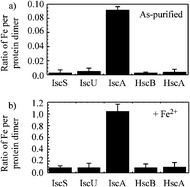Iron–sulphur cluster biogenesis requires coordinated delivery of iron and sulphur to scaffold proteins, followed by transfer of the assembled clusters from scaffold proteins to target proteins. This complex process is accomplished by a group of dedicated iron–sulphur cluster assembly proteins that are conserved from bacteria to humans. While sulphur in iron–sulphur clusters is provided by L-cysteine via cysteine desulfurase, the iron donor(s) for iron–sulphur cluster assembly remains largely elusive. Here we report that among the primary iron–sulphur cluster assembly proteins, IscA has a unique and strong binding activity for mononuclear iron in vitro and in vivo. Furthermore, the ferric iron centre tightly bound in IscA can be readily extruded by L-cysteine, followed by reduction to ferrous iron for iron–sulphur cluster biogenesis. Substitution of the highly conserved residue tyrosine 40 with phenylalanine (Y40F) in IscA results in a mutant protein that has a diminished iron binding affinity but retains the iron–sulphur cluster binding activity. Genetic complementation studies show that the IscA Y40F mutant is inactive in vivo, suggesting that the iron binding activity is essential for the function of IscA in iron–sulphur cluster biogenesis.

You have access to this article
 Please wait while we load your content...
Something went wrong. Try again?
Please wait while we load your content...
Something went wrong. Try again?


 Please wait while we load your content...
Please wait while we load your content...